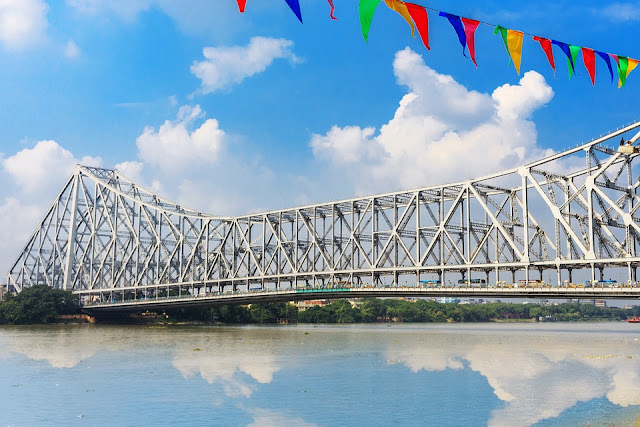Howrah Bridge:
Howrah Bridge One of the pioneers of 19th century bridge engineering and technology Very well known as Howrah Bridge In 1871, the Law Department of Bengal Government passed the Howrah Bridge Act (Act No 9 of 1871). Under this law, the responsibility of the construction of a bridge in the Armenia Ghat or the surrounding government on the Hooghly river between Lieutenant Governor Kelkar and Howrah is given. It was also given the ability to build and preserve the path for the movement and movement of the bridge and toll at specific rates. The deal was signed with the British engineer, Sir Bradford Lasal, for planning, design and implementation of this bridge. Due to technical reasons, some parts of the bridge were made in England and were brought to Kolkata by ship and they were put into the project place.
Completed in 1874, the bridge was considered as the largest floating infrastructure built in Bengal and India. During the construction of a severe cyclonic storm on March 20, 1874, a part of the bridge was devastated. The eruption of a steamer named Eigaria collapsed with the bridge and three pontoons of the bridge were damaged and sinking. As a result, 200 feet of the bridge infrastructure was completely destroyed. The bridge was opened for vehicular movement on 17 October 1874, to rebuild the ruined part. The bridge got a special status for the fancy and originality of design, materials and implementation. There was a way to walk 7 feet wide on both sides of the 1,528 feet long and 62 feet wide bridge. And in the middle it was a 48-foot wide road for traffic. The construction of the bridge was about 60 lakh rupees. The Paltuna Bridge is located in the current 100-yard barrage of present-day Howrah Bridge. Calcutta Port Commissioners took charge of the management of the bridge in 1875. In August 1879, in the middle of the bridge in the middle of the bridge was installed. The work of illuminating the bridge with electricity from Mallikalghat Pumping Station is completed.
In the beginning of the twentieth century, the bridge commissioners formed a committee headed by Chief Engineer John Scott. The committee first gave attention to the construction of a new bridge. In 1922, the Government of Bengal established the new Howrah Bridge Commission. The new Howrah Bridge Act passed in 1926 and the Kolkata Port Commissioners were given the responsibility to supervise the construction of the bridge as the new Howrah Bridge Commissioner. New Howrah Bridge Commissioners give a British company named Cleveland Bridge and Engineering Company Limited to build new bridges. In 1936, the construction of the bridge started and it was completed in 1942. In 1943 the new Howrah Bridge was opened to the public and the old floating Pontoon Bridge was preserved for use as needed. 26,500 tons of steel is used for the construction of the new bridge, and it costs approximately Rs 20 lakhs.
New Hangara Bridge is a hanging and balanced exterior bridge. The bridge is 705 meters long and 30 meters wide. There is a way to walk 15 feet wide on either side of the bridge. The roadway is 71 feet wide.
The new Howrah Bridge is marked by the wonders of the construction world. On 14 June 1965, Tagore Rabindranath Tagore was named as the new name of the Howrah bridge, which was renamed Ravindra Bridge. Every day around 150,000 vehicles and probably more than 200,000 people move on this bridge. Howrah bridge is one of the best in the world.







No comments:
Post a Comment